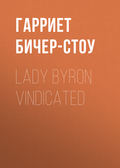
Гарриет Бичер-Стоу
Sunny Memories Of Foreign Lands, Volume 1
These things will live and form high and imperishable elements of our nature, when mankind have learned to develop them in other spheres than that of physical force. Burns's lyric, therefore, has in it an element which may rouse the heart to noble endurance and devotion, even when the world shall learn war no more.
We passed through the town of Stirling, whose castle, magnificently seated on a rocky throne, looks right worthy to have been the seat of Scotland's court, as it was for many years. It brought to our minds all the last scenes of the Lady of the Lake, which are laid here with a minuteness of local description and allusion characteristic of Scott.
According to our guide book, one might find there the visible counterpart of every thing which he has woven into his beautiful fiction—"the Lady's Rock, which rang to the applause of the multitude;" "the Franciscan steeple, which pealed the merry festival;" "the sad and fatal mound," apostrophized by Douglas,—
"That oft has heard the death-axe sound
As on the noblest of the land,
Fell the stern headsman's bloody hand;"—
the room in the castle, where "a Douglas by his sovereign bled;" and not far off the ruins of Cambuskenneth Abbey. One could not but think of the old days Scott has described.
"The castle gates were open flung,
The quivering drawbridge rocked and rung,
And echoed loud the flinty street
Beneath the coursers' clattering feet,
As slowly down the steep descent
Fair Scotland's king and nobles went,
While all along the crowded way
Was jubilee and loud huzza."
The place has been long deserted as a palace; but it is one of the four fortresses, which, by the articles of union between Scotland and England, are always to be kept in repair.
We passed by the town of Perth, the scene of the "Fair Maid's" adventures. We had received an invitation to visit it, but for want of time were obliged to defer it till our return to Scotland.
Somewhere along here Mr. S. was quite excited by our proximity to Scone, the old crowning-place of the Scottish kings; however, the old castle is entirely demolished, and superseded by a modern mansion, the seat of the Earl of Mansfield.
Still farther on, surrounded by dark and solemn woods, stands Glamis Castle, the scene of the tragedy in Macbeth. We could see but a glimpse of it from the road, but the very sound of the name was enough to stimulate our imagination. It is still an inhabited dwelling, though much to the regret of antiquarians and lovers of the picturesque, the characteristic outworks and defences of the feudal ages, which surrounded it, have been levelled, and velvet lawns and gravel walks carried to the very door. Scott, who passed a night there in 1793, while it was yet in its pristine condition, comments on the change mournfully, as undoubtedly a true lover of the past would. Albeit the grass plats and the gravel walks, to the eye of sense, are undoubtedly much more agreeable and convenient. Scott says in his Demonology, that he never came any where near to being overcome with a superstitious feeling, except twice in his life, and one was on the night when he slept in Glamis Castle. The poetical and the practical elements in Scott's mind ran together, side by side, without mixing, as evidently as the waters of the Alleghany and Monongahela at Pittsburg. Scarcely ever a man had so much relish for the supernatural, and so little faith in it. One must confess, however, that the most sceptical might have been overcome at Glamis Castle, for its appearance, by all accounts, is weird and strange, and ghostly enough to start the dullest imagination.
On this occasion Scott says, "After a very hospitable reception from the late Peter Proctor, seneschal of the castle, I was conducted to my apartment in a distant part of the building. I must own, that when I heard door after door shut, after my conductor had retired, I began to consider myself as too far from the living, and somewhat too near the dead. We had passed through what is called 'the King's Room,' a vaulted apartment, garnished with stags' antlers and similar trophies of the chase, and said by tradition to be the spot of Malcolm's murder, and I had an idea of the vicinity of the castle chapel. In spite of the truth of history, the whole night scene in Macbeth's castle rushed at once upon my mind, and struck my imagination more forcibly than even when I have seen its terrors represented by the late John Kemble and his inimitable sister. In a word, I experienced sensations which, though not remarkable either for timidity or superstition, did not fail to affect me to the point of being disagreeable, while they were mingled at the same time with a strange and indescribable kind of pleasure."
Externally, the building is quaint and singular enough; tall and gaunt, crested with innumerable little pepper box turrets and conical towers, like an old French chateau.
Besides the tragedy of Macbeth, another story of still more melancholy interest is connected with it, which a pen like that of Hawthorne, might work up with gloomy power.
In 1537 the young and beautiful Lady Glamis of this place was actually tried and executed for witchcraft. Only think, now! what capabilities in this old castle, with its gloomy pine shades, quaint architecture, and weird associations, with this bit of historic verity to start upon.

Walter Scott says, there is in the castle a secret chamber; the entrance to which, by the law of the family, can be known only to three persons at once—the lord of the castle, his heir apparent, and any third person whom they might choose to take into their confidence. See, now, the materials which the past gives to the novelist or poet in these old countries. These ancient castles are standing romances, made to the author's hands. The castle started a talk upon Shakspeare, and how much of the tragedy he made up, and how much he found ready to his hand in tradition and history. It seems the story is all told in Holingshed's Chronicles; but his fertile mind has added some of the most thrilling touches, such as the sleep walking of Lady Macbeth. It always seemed to me that this tragedy had more of the melancholy majesty and power of the Greek than any thing modern. The striking difference is, that while fate was the radical element of those, free will is not less distinctly the basis of this. Strangely enough, while it commences with a supernatural oracle, there is not a trace of fatalism in it; but through all, a clear, distinct recognition of moral responsibility, of the power to resist evil, and the guilt of yielding to it. The theology of Shakspeare is as remarkable as his poetry. A strong and clear sense of man's moral responsibility and free agency, and of certain future retribution, runs through all his plays.
I enjoyed this ride to Aberdeen more than any thing we had seen yet, the country is so wild and singular. In the afternoon we came in sight of the German Ocean. The free, bracing air from the sea, and the thought that it actually was the German Ocean, and that over the other side was Norway, within a day's sail of us, gave it a strange, romantic charm.
"Suppose we just run over to Norway," said one of us; and then came the idea, what we should do if we got over there, seeing none of us understood Norse.
The whole coast along here is wild and rock-bound; occasionally long points jut into the sea; the blue waves sparkle and dash against them in little jets of foam, and the sea birds dive and scream around them.
On one of these points, near the town of Stonehaven, are still seen the ruins of Dunottar Castle, bare and desolate, surrounded on all sides by the restless, moaning waves; a place justly held accursed as the scene of cruelties to the Covenanters, so appalling and brutal as to make the blood boil in the recital, even in this late day.
During the reigns of Charles and James, sovereigns whom Macaulay justly designates as Belial and Moloch, this castle was the state prison for confining this noble people. In the reign of James, one hundred and sixty-seven prisoners, men, women, and children, for refusing the oath of supremacy, were arrested at their firesides: herded together like cattle; driven at the point of the bayonet, amid the gibes, jeers, and scoffs of soldiers, up to this dreary place, and thrust promiscuously into a dark vault in this castle; almost smothered in filth and mire; a prey to pestilent disease, and to every malignity which brutality could inflict, they died here unpitied. A few escaping down the rocks were recaptured, and subjected to shocking tortures.
A moss-grown gravestone, in the parish churchyard of Dunottar, shows the last resting-place of these sufferers.
Walter Scott, who visited this place, says, "The peasantry continue to attach to the tombs of these victims an honor which they do not render to more splendid mausoleums; and when they point them out to their sons, and narrate the fate of the sufferers, usually conclude by exhorting them to be ready, should the times call for it, to resist to the death in the cause of civil and religious liberty, like their brave forefathers."
It is also related by Gilfillan, that a minister from this vicinity, having once lost his way in travelling through a distant part of Scotland, vainly solicited the services of a guide for some time, all being engaged in peat-cutting; at last one of the farmers, some of whose ancestors had been included among the sufferers, discovering that he came from this vicinity, had seen the gravestones, and could repeat the inscriptions, was willing to give up half a day's work to guide him on his way.
It is well that such spots should be venerated as sacred shrines among the descendants of the Covenanters, to whom Scotland owes what she is, and all she may become.
It was here that Scott first became acquainted with Robert Paterson, the original of Old Mortality.
Leaving Stonehaven we passed, on a rising ground a little to our left, the house of the celebrated Barclay of Ury. It remains very much in its ancient condition, surrounded by a low stone wall, like the old fortified houses of Scotland.
Barclay of Ury was an old and distinguished soldier, who had fought under Gustavus Adolphus in Germany, and one of the earliest converts to the principles of the Friends in Scotland. As a Quaker, he became an object of hatred and abuse at the hands of the magistracy and populace; but he endured all these insults and injuries with the greatest patience and nobleness of soul.
"I find more satisfaction," he said, "as well as honor, in being thus insulted for my religious principles, than when, a few years ago, it was usual for the magistrates, as I passed the city of Aberdeen, to meet me on the road and conduct me to public entertainment in their hall, and then escort me out again, to gain my favor."
Whittier has celebrated this incident in his beautiful ballad, called "Barclay of Ury." The son of this Barclay was the author of that Apology which bears his name, and is still a standard work among the Friends. The estate is still possessed by his descendants.
A little farther along towards Aberdeen, Mr. S. seemed to amuse himself very much with the idea, that we were coming near to Dugald Dalgetty's estate of Drumthwacket, an historical remembrance which I take to be somewhat apocryphal.
It was towards the close of the afternoon that we found ourselves crossing the Dee, in view of Aberdeen. My spirits were wonderfully elated: the grand sea scenery and fine bracing air; the noble, distant view of the city, rising with its harbor and shipping, all filled me with delight. Besides which the Dee had been enchanted for me from my childhood, by a wild old ballad which I used to hear sung to a Scottish tune, equally wild and pathetic. I repeated it to C–, and will now to you.
"The moon had climbed the highest hill
That rises o'er the banks of Dee,
And from her farthest summit poured
Her silver light o'er tower and tree,—
When Mary laid her down to sleep,
Her thoughts on Sandy far at sea,
And soft and low a voice she heard,
Saying, 'Mary, weep no more for me.'
She from her pillow gently raised
Her head, to see who there might be;
She saw young Sandy shivering stand,
With pallid cheek and hollow ee.
'O Mary dear, cold is my clay;
It lies beneath the stormy sea;
The storm, is past, and I'm at rest;
So, Mary, weep no more for me.'
Loud crew the cock; the vision fled;
No more young Sandy could she see;
But soft a parting whisper said,
'Sweet Mary, weep no more for me.'"
I never saw these lines in print any where; I never knew who wrote them; I had only heard them sung at the fireside when a child, to a tune as dreamy and sweet as themselves; but they rose upon me like an enchantment, as I crossed the Dee, in view of that very German Ocean, famed for its storms and shipwrecks.
In this propitious state, disposed to be pleased with every thing, our hearts responded warmly to the greetings of the many friends who were waiting for us at the station house.
The lord provost received us into his carriage, and as we drove along, pointed out to us the various objects of interest in the beautiful town. Among other things, a fine old bridge across the Dee attracted our particular attention.
We were conducted to the house of Mr. Cruikshank, a Friend, and found waiting for us there the thoughtful hospitality which we had ever experienced in all our stopping-places. A snug little quiet supper was laid out upon the table, of which we partook in haste, as we were informed that the assembly at the hall were waiting to receive us.
There arrived, we found the hall crowded, and with difficulty made our way to the platform. Whether owing to the stimulating effect of the air from the ocean, or to the comparatively social aspect of the scene, or perhaps to both, certain it is, that we enjoyed the meeting with great zest. I was surrounded on the stage with blooming young ladies, one of whom put into my hands a beautiful bouquet, some flowers of which I have now dried in my album. The refreshment tables were adorned with some exquisite wax flowers, the work, as I was afterwards told, of a young lady in the place. One of the designs especially interested me. It was a group of water lilies resting on a mirror, which gave them the appearance of growing in the water.
We had some very animated speaking, in which the speakers contrived to blend enthusiastic admiration and love for America with detestation of slavery.
All the afternoon the beautiful coast had reminded me of the State of Maine, and the genius of the meeting confirmed the association. They seemed to me to be a plain, genial, strong, warm-hearted people, like those of Maine.
One of the speakers concluded his address by saying that John Bull and Brother Jonathan, with Paddy and Sandy Scott, should they clasp hands together, might stand against the world; which sentiment was responded to with thunders of applause.
It is because America, like Scotland, has stood for right against oppression, that the Scotch love and sympathize with her. For this reason do they feel it as something taken from the strength of a common cause, when America sides with injustice and oppression. The children of the Covenant and the children of the Puritans are of one blood.
They presented an offering in a beautiful embroidered purse, and after much shaking of hands we went home, and sat down to the supper table, for a little more chat, before going to bed. The next morning,—as we had only till noon to stay in Aberdeen,—our friends, the lord provost, and Mr. Leslie, the architect, came immediately after breakfast to show us the place.
The town of Aberdeen is a very fine one, and owes much of its beauty to the light-colored granite of which most of the houses are built. It has broad, clean, beautiful streets, and many very curious and interesting public buildings. The town exhibits that union of the hoary past with the bustling present which is characteristic of the old world.
It has two parts, the old and the new, as unlike as L'Allegro and Penseroso—the new, clean, and modern; the old, mossy and dreamy. The old town is called Alton, and has venerable houses, standing, many of them, in ancient gardens. And here rises the peculiar, old, gray cathedral. These Scotch cathedrals have a sort of stubbed appearance, and look like the expression in stone of defiant, invincible resolution. This is of primitive granite, in the same heavy, massive style as the cathedral of Glasgow, but having strong individualities of its own.
Whoever located the ecclesiastical buildings of England and Scotland certainly had an exquisite perception of natural scenery; for one notices that they are almost invariably placed on just that point of the landscape, where the poet or the artist would say they should be. These cathedrals, though all having a general similarity of design, seem, each one, to have its own personality, as much as a human being. Looking at nineteen of them is no compensation to you for omitting the twentieth; there will certainly be something new and peculiar in that.
This Aberdeen Cathedral, or Cathedral of St. Machar, is situated on the banks of the River Don; one of those beautiful amber-brown rivers that color the stones and pebbles at the bottom with a yellow light, such as one sees in ancient pictures. Old trees wave and rustle around, and the building itself, though a part of it has fallen into ruins, has, in many parts, a wonderful clearness and sharpness of outline. I cannot describe these things to you; architectural terms convey no picture to the mind. I can only tell you of the character and impression it bears—a character of strong, unflinching endurance, appropriately reminding one of the Scotch people, whom Walter Scott compares to the native sycamore of their hills, "which scorns to be biased in its mode of growth, even by the influence of the prevailing wind, but shooting its branches with equal boldness in every direction, shows no weather side to the storm, and may be broken, but can never be bended."
One reason for the sharpness and distinctness of the architectural preservation of this cathedral is probably that closeness of texture for which Aberdeen granite is remarkable. It bears marks of the hand of violence in many parts. The images of saints and bishops, which lie on their backs with clasped hands, seem to have been wofully maltreated and despoiled, in the fervor of those days, when people fondly thought that breaking down carved work was getting rid of superstition. These granite saints and bishops, with their mutilated fingers and broken noses, seem to be bearing a silent, melancholy witness against that disposition in human nature, which, instead of making clean the cup and platter, breaks them altogether.
The roof of the cathedral is a splendid specimen of carving in black oak, wrought in panels, with leaves and inscriptions in ancient text. The church could once boast in other parts (so says an architectural work) a profusion of carved woodwork of the same character, which must have greatly relieved the massive plainness of the interior.
In 1649, the parish minister attacked the "High Altar," a piece of the most splendid workmanship of any thing of the kind in Europe, and which had to that time remained inviolate; perhaps from the insensible influence of its beauty. It is said that the carpenter employed for the purpose was so struck with the noble workmanship, that he refused to touch it till the minister took the hatchet from his hand and gave the first blow.
These men did not consider that "the leprosy lies deep within," and that when human nature is denied beautiful idols, it will go after ugly ones. There has been just as unspiritual a resting in coarse, bare, and disagreeable adjuncts of religion, as in beautiful and agreeable ones; men have worshipped Juggernaut as pertinaciously as they have Venus or the Graces; so that the good divine might better have aimed a sermon at the heart than an axe at the altar.
We lingered a long time around here, and could scarcely tear ourselves away. We paced up and down under the old trees, looking off on the waters of the Don, listening to the waving branches, and falling into a dreamy state of mind, thought what if it were six hundred years ago! and we were pious simple hearted old abbots! What a fine place that would be to walk up and down at eventide or on a Sabbath morning, reciting the penitential psalms, or reading St. Augustine!
I cannot get over the feeling, that the souls of the dead do somehow connect themselves with the places of their former habitation, and that the hush and thrill of spirit, which we feel in them, may be owing to the overshadowing presence of the invisible. St. Paul says, "We are compassed about with a great cloud of witnesses." How can they be witnesses, if they cannot see and be cognizant?
We left the place by a winding walk, to go to the famous bridge of Balgounie, another dream-land affair, not far from here. It is a single gray stone arch, apparently cut from solid rock, that spans the brown rippling waters, where wild, overhanging banks, shadowy trees, and dipping wild flowers, all conspire to make a romantic picture. This bridge, with the river and scenery, were poetic items that went, with other things, to form the sensitive mind of Byron, who lived here in his earlier days. He has some lines about it:—
"As 'auld lang syne' brings Scotland, one and all,
Scotch, plaids, Scotch snoods, the blue hills and clear streams,
The Dee, the Don, Balgounie's brig's black wall,
All my boy-feelings, all my gentler dreams,
Of what I then dreamt clothed in their own pall,
Like Banquo's offspring,—floating past me seems
My childhood, in this childishness of mind:
I care not—'tis a glimpse of 'auld lang syne.'"

This old bridge has a prophecy connected with it, which was repeated to us, and you shall have it literatim:—
"Brig of Balgounie, black's your wa',
Wi' a wife's ae son, and a mare's a foal,
Doon ye shall fa'!"
The bridge was built in the time of Robert Bruce, by one Bishop Cheyne, of whom all that I know is, that he evidently had a good eye for the picturesque.
After this we went to visit King's College. The tower of it is surmounted by a massive stone crown, which forms a very singular feature in every view of Aberdeen, and is said to be a perfectly unique specimen of architecture. This King's College is very old, being founded also by a bishop, as far back as the fifteenth century. It has an exquisitely carved roof, and carved oaken seats. We went through the library, the hall, and the museum. Certainly, the old, dark architecture of these universities must tend to form a different style of mind from our plain matter-of-fact college buildings.
Here in Aberdeen is the veritable Marischal College, so often quoted by Dugald Dalgetty. We had not time to go and see it, but I can assure you on the authority of the guide book, that it is a magnificent specimen of architecture.
After this, that we might not neglect the present in our zeal for the past, we went to the marble yards, where they work the Aberdeen granite. This granite, of which we have many specimens in America, is of two kinds, one being gray, the other of a reddish hue. It seems to differ from other granite in the fineness and closeness of its grain, which enables it to receive the most brilliant conceivable polish. I saw some superb columns of the red species, which were preparing to go over the Baltic to Riga, for an Exchange; and a sepulchral monument, which was going to New York. All was busy here, sawing, chipping, polishing; as different a scene from the gray old cathedral as could be imagined. The granite finds its way, I suppose, to countries which the old, unsophisticated abbots never dreamed of.
One of the friends who had accompanied us during the morning tour was the celebrated architect, Mr. Leslie, whose conversation gave us all much enjoyment. He and Mrs. Leslie gave me a most invaluable parting present, to wit, four volumes of engravings, representing the "Baronial and Ecclesiastical Antiquities of Scotland," illustrated by Billings. I cannot tell you what a mine of pleasure it has been to me. It is a proof edition, and the engravings are so vivid, and the drawing so fine, that it is nearly as good as reality. It might almost save one the trouble of a pilgrimage. I consider the book a kind of national poem; for architecture is, in its nature, poetry; especially in these old countries, where it weaves into itself a nation's history, and gives literally the image and body of the times.







